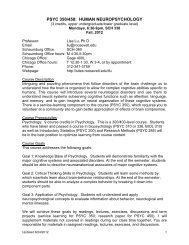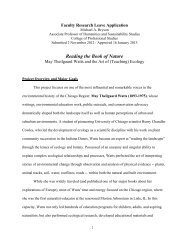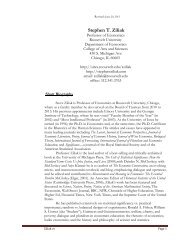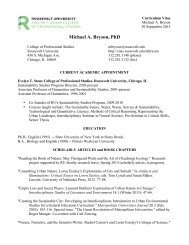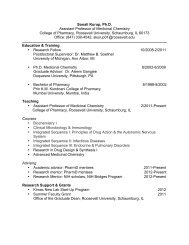Social Insurance and Public Assistance
public-assistance-welfare-reform-colonial-times-to-the-present-ziliak ...
public-assistance-welfare-reform-colonial-times-to-the-present-ziliak ...
You also want an ePaper? Increase the reach of your titles
YUMPU automatically turns print PDFs into web optimized ePapers that Google loves.
POOR RELIEF Series Bf 176–187 733<br />
TABLE Bf 176–187 Local public relief recipients in New York State <strong>and</strong> New York City, by type of relief: 1840–1895<br />
Continued<br />
Source<br />
Previously unpublished data compiled from the following sources: New York<br />
Secretary of State Annual Reports of the Secretary of State In Relation to the Statistics<br />
of the Poor, 1831–1896, in New York State Legislature, Assembly, Assembly<br />
Documents 1831, volume 1, number 66; 1832, volume 1, number 33; 1833,<br />
volume 2, number 38; 1834, volume 3, number 173; 1835, volume 3, number<br />
185; 1836, volume 2, number 72; 1837, volume 3, number 270; 1838, volume<br />
6, number 311; 1839, volume 3, number 146; 1840, volume 8, number 332;<br />
1841, volume 7, number 227; 1842, volume 5, number 121; 1843, volume<br />
2, number 38; 1845, volume 5, number 197; 1850, volume 6, number 169;<br />
1851, volume 5, number 147; 1853, volume 6, number 120; 1854, volume<br />
4, number 144; 1856, volume 5, number 214; 1858, volume 1, number 10;<br />
1859, volume 3, number 101; 1860, volume 2, number 71; 1861, volume<br />
2, number 60; 1863, volume 8, number 230; 1864, volume 8, number 198;<br />
1865, volume 7, number 147; 1866, volume 7, number 165; 1867, volume<br />
7, number 145; 1868, volume 9, number 88; 1869, volume 6, number 79;<br />
1870, volume 6, number 124; 1871, volume 3, number 46; 1872, volume 3,<br />
number 48; 1873, volume 3, number 32; 1877, volume 9, number 142; 1880,<br />
volume 3, number 62; 1881, volume 4, number 64; 1882, volume 2, number<br />
34; 1884, volume 5, number 59; 1885, volume 5, number 45; 1886, volume<br />
3, number 45; 1887, volume 7, number 46; 1890, volume 10, number 58;<br />
1891, volume 12, number 60; 1892, volume 6, number 43; 1893, volume<br />
10, number 58; 1894, volume 10, number 72; 1895, volume 13, number 74;<br />
1896, volume 18, number 84; <strong>and</strong> New York State Legislature, Senate, Senate<br />
Documents, 1844, volume 2, number 73; 1847, volume 3, number 100; 1848,<br />
volume 3, number 79; 1849, volume 3, number 83; 1855, volume 3, number<br />
72; 1857, volume 4, number 131; 1862, volume 4, number 65; 1874, volume<br />
4, number 62; 1875, volume 4, number 52; 1876, volume 3, number 46;<br />
1878, volume 2, number 28; 1879, volume 2, number 34; 1883, volume 2,<br />
number 25; 1888, volume 5, number 44; <strong>and</strong> 1889, volume 6, number 40,<br />
<strong>and</strong> from New York State Board of Charities, Annual Reports, 1875–1897.<br />
Documentation<br />
See the essay in this chapter on public assistance, colonial times to the 1920s,<br />
for additional information on public relief in New York.<br />
Five-year averages of relief recipients as a percentage of the population<br />
<strong>and</strong> of the fraction of all recipients supported in the poorhouse appear in<br />
Joan Underhill Hannon, “Shutting Down Welfare: Two Cases From America’s<br />
Past,” Quarterly Review of Economics <strong>and</strong> Finance 37 (2) (1997): 419–38. Relief<br />
recipient data reported here reflect minor corrections <strong>and</strong> revisions to that<br />
reported for 1835–1860 in Joan Underhill Hannon, “Poverty in the Antebellum<br />
Northeast: The View from New York State’s Poor Relief Rolls,” Journal of<br />
Economic History 44 (4) (1984): 1007–32, <strong>and</strong> Joan Underhill Hannon, “Poor<br />
Relief Policy in Antebellum New York State: The Rise <strong>and</strong> Decline of the Poorhouse,”<br />
Explorations in Economic History (Academic Press, 1984), Tables 1 <strong>and</strong> 5.<br />
Over the second half of the nineteenth century, state law gradually transferred<br />
some categories of relief recipients out of the system of local outdoor<br />
<strong>and</strong> poorhouse relief. Most significantly, an 1865 act required the removal<br />
of insane paupers from poorhouses to state asylums, <strong>and</strong> an 1875 act m<strong>and</strong>ated<br />
the removal of children from poorhouses to orphanages or other<br />
charitable institutions. Though local governments paid for the support of<br />
the insane <strong>and</strong> children in these institutions, the recipients are not included<br />
in the data on local public relief recipients, series Bf176–185. Estimates of<br />
the number of recipients involved are reported in Joan Underhill Hannon,<br />
“<strong>Public</strong> Relief Dependency before the Welfare State: The Interplay of Life<br />
Cycles, Labor Markets, <strong>and</strong> Policy in Nineteenth Century New York State”<br />
(unpublished manuscript presented to the American Economic Association,<br />
January 1997), Figure 2.<br />
The relief recipient data are constructed from two tables in the New<br />
York Secretary of State’s Annual Reports on Statistics of the Poor. Table A reports<br />
by county the whole number of paupers relieved or supported <strong>and</strong><br />
the number of persons temporarily relieved during the year ended December<br />
1ofeach year. Table E reports by county the number of persons received<br />
into <strong>and</strong> born in the poorhouse <strong>and</strong> the number who left the poorhouse<br />
(died, bound out, discharged, or absconded) during the year, along with the<br />
number remaining in the poorhouse on December 1. Unfortunately, some<br />
counties failed to provide information in some categories; <strong>and</strong> in deriving<br />
state totals, the published reports did not distinguish between zeros <strong>and</strong><br />
missing data. Moreover, individual county reports on the number of recipients<br />
are often internally inconsistent.<br />
The reports offer three logical ways to calculate the number supported<br />
in the poorhouse during the year. First, one can subtract the number temporarily<br />
relieved outdoors from the total relieved <strong>and</strong> supported. Second,<br />
one can add the number in the poorhouse at the end of the previous year<br />
to the number received <strong>and</strong> born in the poorhouse during the year. Third,<br />
one can take the sum of those reported leaving the poorhouse during the<br />
year <strong>and</strong> those remaining in the poorhouse at year-end. The three methods<br />
often yielded different results. Sometimes the reason for the discrepancy was<br />
readily apparent. Quite often, for example, it was clear that a county had<br />
included those already in the poorhouse at the end of the previous year in<br />
the number for those received during the year, producing by method 2 a<br />
figure that was too high by exactly the number in the house at the end of the<br />
previous year. If the source of the discrepancy could not be identified <strong>and</strong><br />
corrected, the figures reported for number of persons supported in county<br />
<strong>and</strong> city poorhouses during the year (series Bf178, Bf182, <strong>and</strong> Bf185) for<br />
the period from 1840 to 1875 are based on the following procedure: If the<br />
differences between the three estimates were small (on the order of less than<br />
5 percentage points), the middle figure was used. If the unexplained discrepancy<br />
was large, the data for that county were not used for that year.<br />
Beginning in 1875, all issues of Annual Reports of the New York State Board of<br />
Charities include data on local public relief. Though the State Board of Charities<br />
worked with the same county superintendents’ annual reports to the<br />
Secretary of State, the Board of Charities did not simply replicate the tables<br />
from the Secretary of State’s Annual Reports. Instead, the Board of Charities<br />
calculated the number of poorhouse recipients according to the second procedure<br />
described earlier (the sum of the number in the poorhouse at the end<br />
of the previous years, <strong>and</strong> those received <strong>and</strong> those born in the poorhouse<br />
during the year). They added the resulting figure to the number temporarily<br />
relieved outdoors to get the total number relieved <strong>and</strong> supported. The figures<br />
reported by the State Board of Charities are always internally consistent but<br />
do not always match those reported by the Secretary of State. Often, notes<br />
to the tables indicate that the Board of Charities returned a report to the<br />
county superintendent for correction or clarification. For the period 1875–<br />
1895, the three methods outlined here were used to derive estimates of the<br />
number supported in the poorhouse from the Annual Reports of the Secretary of<br />
State <strong>and</strong> those were compared with the figure reported by the State Board<br />
of Charities. If one of the estimates matched that of the Board of Charities<br />
or if the differences between them were small, the figure from the Board of<br />
Charities was used. If there were large inexplicable discrepancies, the data<br />
for that county were not used for that year.<br />
Series Bf176, Bf179, <strong>and</strong> Bf183. Calculated as the sum of the series on<br />
persons receiving temporary outdoor relief <strong>and</strong> those supported in the poorhouse.<br />
The series include only those counties for which both poorhouse<br />
<strong>and</strong> temporary outdoor recipient data are available. Though the counties<br />
included in the data set are the same for all series in a given year, included<br />
counties vary from year to year. As a result, the raw data may not accurately<br />
reflect year-to-year fluctuations in the total number of recipients; <strong>and</strong> per<br />
capita figures should not be calculated using total state population in the<br />
denominator. For this purpose, series Bf186–187 provide the population of<br />
counties covered by public poor relief data for New York State <strong>and</strong> for the<br />
state excluding New York City, assuming constant exponential population<br />
growth in each county between Census years.<br />
Series Bf180–181. For 1840–1868, the data come directly from the Annual<br />
Reports of the Secretary of State.From 1869 through 1893, all issues of the Annual<br />
Reports of the Secretary of State report the number of families receiving temporary<br />
outdoor relief in New York City, series Bf181, rather than the number of<br />
individuals. For four of those years, 1890–1893, the number of persons receiving<br />
temporary outdoor relief in New York City is reported in the Annual Report<br />
of the State Board of Charities, <strong>and</strong> those figures are included in series Bf180.<br />
Series Bf184. Derived from the Annual Reports of the Secretary of State, but includes<br />
only those counties for which data on the number supported in the<br />
poorhouse are also available.



